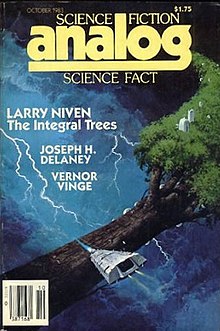Setting
The story occurs around the fictional neutron star Levoy's Star (abbreviated "Voy"). The gas giant Goldblatt's World (abbreviated "Gold") orbits this star just outside its Roche limit and therefore its gravity is insufficient to keep its atmosphere, which is pulled loose into an independent orbit around Voy and forms a ring that is known as a gas torus. The gas torus is huge—one million kilometers thick—but most of it is too thin to be habitable. The central part of the Gas Torus, where the air is thicker, is known as the Smoke Ring. The Smoke Ring supports a wide variety of life.
No "ground" exists in the Smoke Ring; it consists entirely of sky. Furthermore, the Smoke Ring is in orbit and therefore in free fall: there is no "up" or "down". Most animals have trilateral symmetry that allows them to see in all directions. The majority of Smoke Ring animals have evolved to fly on at least an occasional basis—even the fish. The Smoke Ring contains numerous "ponds," globs of water of various sizes which float free like everything else. While there are aquatic and amphibious animals in the Smoke Ring that live the majority of their lives in such ponds, these animals may find their habitat unsuitable at any moment. Whether their home pond drifts too far out of the habitable center of the Smoke Ring and into the gas torus, becomes too large and breaks up due to tidal forces, or impacts a large object such as an integral tree, aquatic animals must be able to propel themselves through the air sometimes in order to find a new place to live.
Most plants in the Smoke Ring are quite fragile because they do not need to support their own weight. A notable exception to this rule are the eponymous Integral Trees, which can grow up to 100 kilometers long. Tidal locking causes them to be radially oriented, with one end pointing in toward Voy while the other points toward space. The ends of the tree feel a tidal force of up to 1/5 g0 on the largest trees. Each end of a tree is a green, leafy tuft.
An integral tree tuft is up to 50 kilometers from the tree's center of mass. Thus, a tuft is either orbiting too slowly (the "in" tuft) or too quickly (the "out" tuft) compared to the atmosphere, which is in orbit at all points. The ends of the tree are therefore subject to a constant gale-force wind that causes the ends to curve into the shape of an integral symbol ∫ and pushes water and food onto the tufts, or (less forcefully) onto the trunk, where the gravity-like tidal forces pull the material out towards the tufts.
Each tuft serves several main purposes for the tree. First, the green foliage is photosynthetic, providing the tree with energy from sunlight; second, the tufts are where the tree produces its seeds; and third, various plants, animals, and sundry other objects can become trapped in the tighter branches, which gradually migrate toward the "treemouth." The treemouth, a pit at the top of each tuft on the lee side of the trunk, is the integral tree's root; water collected along the trunk flows down due to tidal forces and is ingested by the treemouth. Tuft branches catch and capture various things and animals in the wind and gradually, over the course of years, migrate to the treemouth, where they and their catch are absorbed by the tree for nourishment. Many other large Smoke Ring plants have a scavenger/carnivore aspect similar to this, though with somewhat different mechanisms.
Plot summary
Twenty astronauts aboard an interstellar "ramship" colonized the Smoke Ring five hundred years before the story begins. Their descendants have adapted their cultures to the free-fall environment. Without gravity, even those who live in integral tree tufts are much taller than Earth-average humans, having grown up in much weaker tides. Many people are able to use their longer, prehensile toes as another set of fingers. The small number of devices left from the original crew are coveted items in Smoke Ring societies.
Quinn Tribe inhabits the "in tuft" of Dalton-Quinn tree. They normally subsist on the tree's cottony foliage, augmented by hunting and a flock of domesticated turkeys. But since the tree passed near Gold six earth years ago it has been falling toward Voy, nearly dropping out of the Smoke Ring. As a result, the tribe suffers a severe drought. The tribe's leader, the chairman, decides to send a party of nine up the tree, ostensibly to hunt and re-cut tribal markings into the trunk. The group consists mostly of people with disability and people the chairman dislikes, including the chairman's son-in-law (and rival) Clave, and Jeffer, the Scientist's apprentice.
When they approach the midpoint they notice that the tribal markings are different; upon reaching it, they are attacked by members of the Dalton-Quinn tribe who live at the other end of the tree. During the battle a massive tremor splits the tree in half, causing the in tuft to fall farther toward Voy (killing its inhabitants) and allowing the out tuft to find a new equilibrium that is closer to the Smoke Ring's median. The seven surviving members of the Quinn Tribe and one of the attackers jump clear of the shattered tree and are left adrift in the sky with only a few "jet pods" (high pressure seed cases that provide a temporary thrust when opened) as their only method of propulsion.
Before dying of thirst, they hook a passing "moby" (a flying whale-like creature) which takes them to a "jungle," which is a floating mass of plant life. They cut loose, crash, and find themselves in the middle of a battle between the Carther States, who live in the jungle, and slave-runners from London Tree. The group is split when six of them are captured by the slavers; the other two remain in the jungle.
Carther States counter-attacks some weeks later, and the Quinn Tribe group is reunited. During the battle they steal London Tree's CARM (Cargo And Repair Module), a small spacecraft—a relic of the original settlers. The CARM is still functional due to careful management and its robust design; its solar panels provide electricity to electrolyze water into hydrogen and oxygen, which it stores automatically and then burns for propulsion as needed. London Tree's "Navy", bow- and spear-armed warriors, use the CARM to conduct long-distance military actions and slave raids on a scale impossible for wingless humans in a zero-g environment.
Not fully understanding how to pilot the CARM, the Quinn and Carther warriors engage its main rocket motor, which accelerates the ship at several g, enough to prevent the crew from reaching the controls to turn the motor off. The CARM is propelled up into the thinnest part of the gas torus before running dangerously low on fuel. As a result, they become the first Smoke Ring inhabitants in centuries to see the naked stars.
Unknown to any of the inhabitants of the Smoke Ring, Discipline, the ship in which their ancestors arrived, remains in orbit, and its AI autopilot, Kendy, has been attempting to watch their progress. When Kendy sees the CARM dangerously far from the habitable area of the Ring he contacts them. With help from the on-board computer and after some interaction with Kendy, the occupants of the CARM eventually safely return to the Smoke Ring. Unable to reach any of the trees that they know, they decide to settle on a new tree, which they dub "Citizens' Tree".
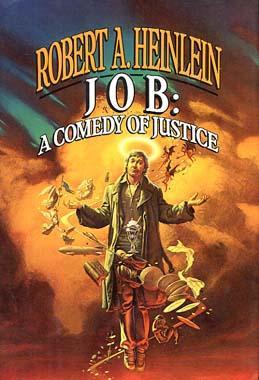
Job: A Comedy of Justice is a science fiction novel by American writer Robert A. Heinlein published in 1984. The title is a reference to the biblical Book of Job and James Branch Cabell's book Jurgen, A Comedy of Justice. It won the Locus Award for Best Fantasy Novel in 1985 and was nominated for the Nebula Award for Best Novel in 1984, and the Hugo Award for Best Novel in 1985.

Gilgamesh the King is a 1984 historical novel by American writer Robert Silverberg, presenting the Epic of Gilgamesh as a novel. In the afterword the author wrote "at all times I have attempted to interpret the fanciful and fantastic events of these poems in a realistic way, that is, to tell the story of Gilgamesh as though he were writing his own memoirs, and to that end I have introduced many interpretations of my own devising which for better or for worse are in no way to be ascribed to the scholars".
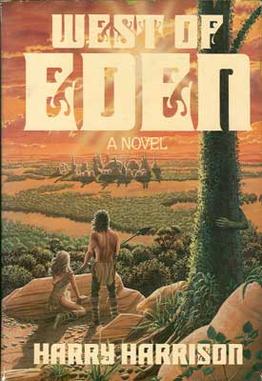
West of Eden is a 1984 science fiction novel by American writer Harry Harrison.

The Smoke Ring is a 1987 science fiction novel by Larry Niven. Like much of Niven's work, the story is heavily influenced by the setting: a gas torus, a ring of air around a neutron star. It is a sequel to The Integral Trees.
Valentine Pontifex is a novel by Robert Silverberg published in 1983.

The Gaea Trilogy consists of three science fiction novels by John Varley. The stories tell of humanity's encounter with a living being in the shape of a 1,300 km diameter Stanford torus, inhabited by many different species, most notably the centaur-like Titanides, in orbit around the planet Saturn.

A World Out of Time is a science fiction novel by Larry Niven and published in 1976. It is set outside the Known Space universe of many of Niven's stories, but is otherwise fairly representative of his 1970s hard science fiction novels. The main part of the novel was originally serialized in Galaxy magazine as "Children of the State"; another part was originally published as the short story "Rammer". A World Out of Time placed fifth in the annual Locus Poll in 1977.

The Descent of Anansi is a 1982 science fiction novel by American writers Steven Barnes and Larry Niven.
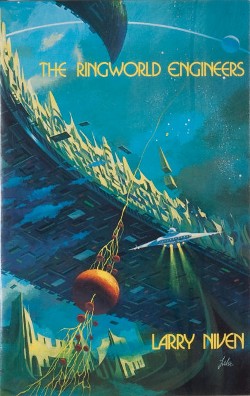
The Ringworld Engineers is a 1979 science fiction novel by American writer Larry Niven. It is the first sequel to Niven's Ringworld and was nominated for both the Hugo and Locus Awards in 1981.

The Unteleported Man is a 1966 science fiction novel by American writer Philip K. Dick, first published as a novella in 1964. It is about a future in which a one-way teleportation technology enables 40 million people to emigrate to a colony named Whale's Mouth on an Earth-like planet, which advertisements show as a lush green utopia. When the owner of a failing spaceship travel firm tries to take the 18-year flight to the colony to bring back any unhappy colonists, powerful forces try to stop him from finding out the truth.
Planets outside of the Solar System have been featured as settings in works of fiction. Most of these fictional planets do not vary significantly from the Earth. Exceptions include planets with sentience, planets without stars, and planets in multiple-star systems where the orbital mechanics can lead to exotic day–night or seasonal cycles.
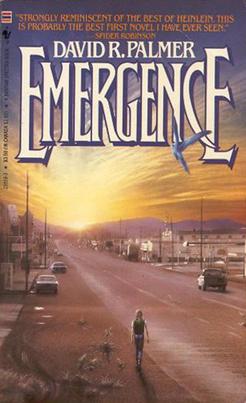
Emergence is a science fiction novel by American writer David R. Palmer. It first appeared as a novella published in Analog Science Fiction in 1981; the same magazine also published Part II, "Seeking", in 1983. The completed novel then was published by Bantam in 1984. The plot follows a precocious 11-year-old orphan girl, living in a post-apocalyptic United States. It had three printings through July 1985, and was republished in 1990 as a "Signature Special Edition" with a few minor edits and a new afterword by the author.
The State is a fictional totalitarian world government in a future history that forms the back-story of three of Larry Niven's novels: A World Out of Time (1976), The Integral Trees (1984), and The Smoke Ring (1987). It is also the setting of two short stories, "Rammer" and "The Kiteman", as well as a stalled fourth novel, The Ghost Ships. After several years in development, Niven announced that The Ghost Ships would never be made and wrote The Ringworld Throne instead. The novel would have focused on a race of self-aware natural Bussard ramjets birthed in the supernova that created Levoy's Star and were returning to their place of birth to mate. According to Playgrounds of the Mind, Kendy and the kite-fliers from "The Kiteman" would have returned also.

Terry Carr's Best Science Fiction of the Year is an anthology of science fiction short stories edited by Terry Carr, the fourteenth volume in a series of sixteen. It was first published in paperback by Tor Books in July 1985, and in hardcover and trade paperback by Gollancz in October of the same year, under the alternate title Best SF of the Year #14.
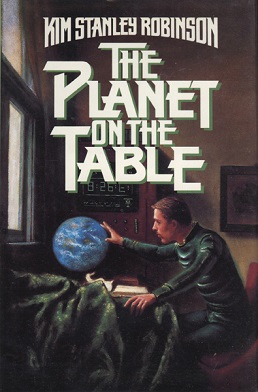
The Planet on the Table is a collection of science fiction stories by American writer Kim Stanley Robinson, published in hardcover by Tor Books in 1986. A British paperback edition appeared in 1987, as well as a Tor paperback reprint; a French translation was issued in 1988. The collection was republished in the 1994 Tor omnibus Remaking History and Other Stories. The collection takes its title from a poem by Wallace Stevens, which provides the book's epigraph.
Helliconia Summer is a novel by Brian Aldiss published in 1983.
A list of works by, or about, the American science fiction author Larry Niven.
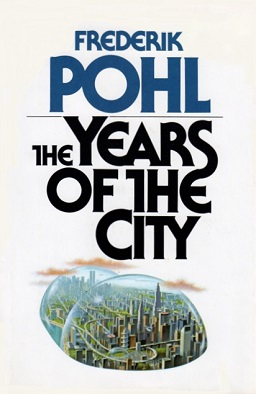
The Years of the City is a novel by Frederik Pohl published in 1984.
The Man in the Tree is a novel by Damon Knight published in 1984.
Green Eyes is a novel by Lucius Shepard published in 1984.
